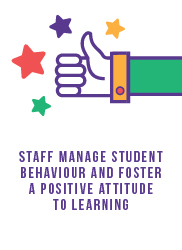Behaviour for Learning: Consistency (systems) and low-level disruption
 Open door policy
Open door policy
Following the news from Europe over the weekend, it is important to remember that we are still in a pandemic, so please ensure that your classroom door remains open during lessons and that the room is well ventilated. Thank you for the superb examples of “end & send” that we have witnessed over the past weeks. Please continue to adopt the “50:50” approach at the beginning and end of lessons, allowing students an opportunity to say thank you for their lesson, whilst you support in monitoring corridor behaviour.
Masks
Now that students and staff should be wearing masks in communal areas, it is a clever idea to get your class to put on their masks before they leave your lesson so that you do not have to address missing masks as you end and send your lesson.
Behaviour Drop-in surgery
Thank you to those staff that attended our first surgery. We had a lovely mix of experienced staff and those newer to the profession, who were able to discuss and share different behaviour strategies over their lunch. Please feel free to pop along to our next one on Wednesday 1st December, in GG13.
Bill Rogers - Top Tips
Low-level disruption within the classroom can be one of the most frustrating things to deal with as a teacher. Bill Rogers offers some strategies in dealing with this, summarised below. Last year, we offered some examples of these in practice and have shared some again below.
- Positive Correction: the basic premise that teachers and schools should adopt a non-confrontational approach to discipline, based on positive teacher-student relationships, respect for the dignity and rights of individuals, choices about consequences of behaviour and encouragement for student self-discipline.
- Prevention: planning for good behaviour; teaching the routines and the rules.
- Consequences: have a clear structure that students understand and use to inform the choices they make.
- Repair & Rebuild: the imperative to work hard to build and repair the damage that is done when things do not work out.
No Why Questions
Harpal Sagoo avoids asking students why they are doing what they are doing so as not to inflame them. Students can often not have their correct PE kit. Harpal, rather than asking why they do not have their full PE kit, asks the students what the rules are about PE kit and what students need to do in future to observe the rules. This avoids unnecessary confrontation and changes students’ behaviour. This is an on-the-spot reaction at the start of the lesson but is something that might need more exploration for repeat offenders.
Direction with tactical pausing
Kathryn Thomas uses this effectively with one of her lower set classes at the start of the lesson. Students are often slow to settle and get on task, so she makes it clear what she wants students to do rather than focussing on what she does not want them to do. For example, Kathryn might say, “Omar Ali please take your coat off and sit down.” She does this in a welcoming, calm, and friendly tone even though she is addressing behaviour.
Blocking with partial agreement
Dan Siskin uses this during restorative conversations. He listens to what students have to say regarding the incident and his response is often, “Maybe you didn’t say/do that, but I have a report here from a teacher that you did.” This depersonalises the conversation, so a student does not feel attacked and responds in a way to match that feeling
If you have any questions or want any support regarding the things discussed in the behaviour for learning section of connect, please get in touch.
We hope you have a wonderful week.
Mark and Jo